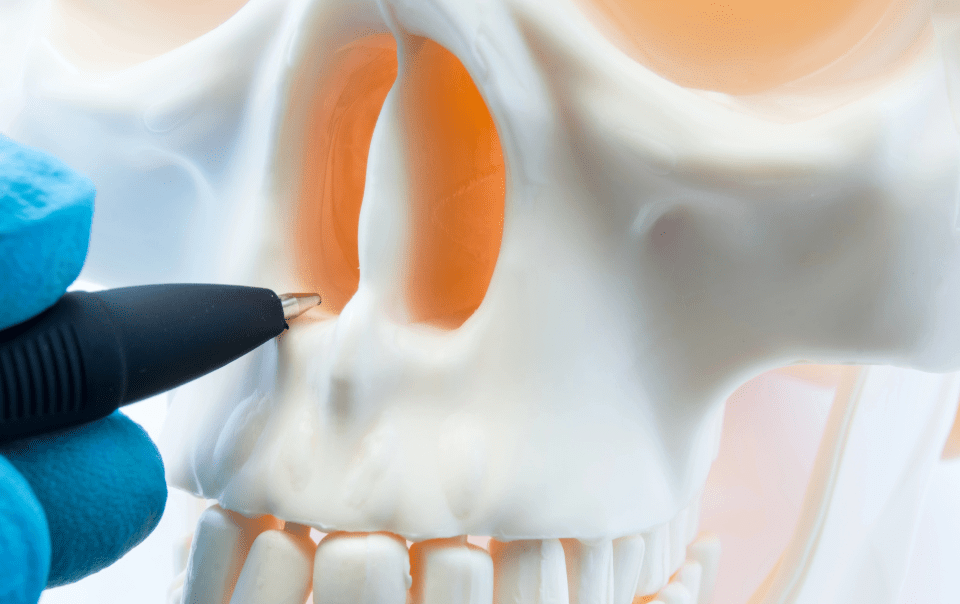Breathing through your nose should feel natural and effortless, but for many people, this isn’t always the case. You might have a deviated septum if you often find it hard to breathe through your nose, feel like one side is more blocked than the other, or experience frequent nasal congestion without a cold or allergies.
A deviated septum occurs when the thin wall (called the septum) that divides your nasal passages is off-center or crooked, making one nasal passage smaller than the other. While some people may live with a mild deviation and hardly notice it, others can experience significant nasal obstruction, leading to various issues, from breathing difficulties to frequent sinus infections.
In this blog, we’ll cover everything you need to know about nasal obstruction caused by a deviated septum, including the symptoms, causes, diagnosis, and treatment options available to help you breathe easier.
What Is a Deviated Septum?
The septum is the thin cartilage and bone that divides your nose into two nasal passages. Ideally, the septum should run down the center of your nose, providing equal airflow through both sides. However, when the septum is deviated, it leans more to one side, making one nasal passage smaller and restricting airflow.
A deviated septum can be caused by a variety of factors, including:
- Congenital conditions: Some people are born with a deviated septum. It can develop naturally during fetal growth or as part of genetic traits.
- Injury or trauma: A blow to the nose, often from sports injuries, falls, or accidents, can cause the septum to shift out of place. Even minor injuries from childhood may cause a deviated septum later in life.
- Age-related changes: As we age, the cartilage and tissues in the nose can weaken, making a previously mild deviation more noticeable.
While many people have a slightly deviated septum, it’s only when the deviation is severe that it can cause symptoms and affect your ability to breathe normally.
Also Read: Deviated Septum Symptoms You Shouldn’t Ignore
Signs and Symptoms of a Deviated Septum
One of the most common symptoms of a deviated septum is nasal obstruction, which can make breathing through your nose feel difficult or blocked. Here are some of the key signs and symptoms to look out for:
1. Difficulty Breathing Through One or Both Sides of the Nose
People with a deviated septum often feel like one side of their nose is more blocked than the other. This blockage can make it hard to breathe through the affected side, especially during exercise or when lying down.
2. Frequent Nasal Congestion
Nasal obstruction from a deviated septum can lead to chronic congestion, making it feel like you constantly have a stuffy nose, even when you don’t have a cold or allergies.
3. Nosebleeds
The airflow changes caused by a deviated septum can dry out the nasal passages, making the delicate lining of the nose more prone to irritation and bleeding.
4. Sinus Infections
Frequent sinus infections are another sign of a deviated septum. The narrowed nasal passage makes it harder for mucus to drain properly, leading to congestion, inflammation, and infections in the sinuses.
5. Snoring and Sleep Issues
A deviated septum can cause snoring and even contribute to sleep disorders like sleep apnea. If you or your partner notice loud snoring or pauses in your breathing while you sleep, it could be linked to nasal obstruction from a deviated septum.
6. Headaches and Facial Pain
Some people with a deviated septum experience headaches or facial pain, particularly in the areas around the eyes, forehead, or cheeks. This discomfort may be due to sinus pressure or nasal congestion caused by the deviation.
How Is a Deviated Septum Diagnosed?
If you suspect you have a deviated septum, the best course of action is to visit an ear, nose, and throat (ENT) specialist or a healthcare provider. They will likely begin by asking about your symptoms and conducting a physical examination of your nose using a special instrument called a nasal speculum.
The ENT may also use a nasal endoscopy, a thin, flexible tube with a camera, to look inside your nasal passages more closely. This procedure helps them see the extent of the deviation and identify any other potential issues, like nasal polyps or swelling that could also be contributing to your symptoms.
In some cases, imaging tests like CT scans may be needed to assess the severity of the deviation and its impact on your sinuses.
Also Read: Deviated Septum Surgery and Seasonal Allergies
Treatment Options for Nasal Obstruction From a Deviated Septum

1. Non-Surgical Treatments
If your symptoms are mild, your doctor may recommend non-surgical treatments to manage your nasal obstruction. These treatments won’t correct the deviation but can help reduce inflammation, improve airflow, and relieve congestion.
- Nasal steroid sprays: These sprays reduce inflammation in the nasal passages, helping to open them up and make breathing easier.
- Decongestants: Over-the-counter decongestants can temporarily relieve nasal congestion and improve airflow. However, these should be used with caution, as long-term use can lead to rebound congestion.
- Antihistamines: If allergies are contributing to your nasal congestion, antihistamines can help reduce inflammation and relieve symptoms.
- Nasal strips: These adhesive strips are applied to the outside of your nose and work by gently pulling the nostrils open, making it easier to breathe, especially during sleep.
While these treatments can provide temporary relief, they won’t address the underlying structural issue of the deviated septum.
2. Septoplasty: The Surgical Solution
For those with more severe symptoms, septoplasty is the most effective treatment. Septoplasty is a surgical procedure that corrects the position of the septum, straightening it and improving airflow through both nasal passages.
What Happens During Septoplasty?
Septoplasty is typically performed under local or general anesthesia. During the procedure, the surgeon will make an incision inside the nose to access the septum. They will then remove or reshape the deviated cartilage and bone to reposition the septum in the center of the nose.
Deviated septum surgery in West Hills usually takes about an hour, and most people can go home the same day. After the procedure, you can expect some swelling and congestion as your nose heals, but this typically improves within a few weeks.
Benefits of Septoplasty:
- Improved breathing: The most significant benefit of septoplasty is improved airflow through your nasal passages, making it easier to breathe.
- Reduced sinus infections: By improving mucus drainage, septoplasty can reduce the frequency of sinus infections.
- Better sleep: Many people report reduced snoring and better sleep quality after septoplasty.
- Increased quality of life: Restoring normal breathing can significantly improve your overall well-being and quality of life.
Also Read: Deviated Septum Relief: Pros and Cons of Septoplasty
Living With a Deviated Septum
Living with a deviated septum can be challenging, especially if it causes frequent congestion, sinus infections, or sleep issues. While non-surgical treatments can help manage mild symptoms, surgery may be the best option for those with severe nasal obstruction.
If you’re unsure whether surgery is right for you, consider how much your symptoms impact your daily life. Are you constantly struggling to breathe through your nose? Do you suffer from chronic sinus infections or poor sleep? If so, consulting with an ENT specialist can help you explore your treatment options and find relief.
Final Thoughts
A deviated septum is a common condition that affects millions of people. While it may not always cause symptoms, when it does, it can lead to significant discomfort and breathing difficulties. Fortunately, whether through non-surgical methods or septoplasty, effective treatments are available to help restore normal breathing and improve your quality of life.
If you suspect that a deviated septum is causing your nasal obstruction, don’t hesitate to contact the Southern California Sinus Institute. With the right diagnosis and treatment, you can breathe easier and enjoy a healthier, more comfortable life.

